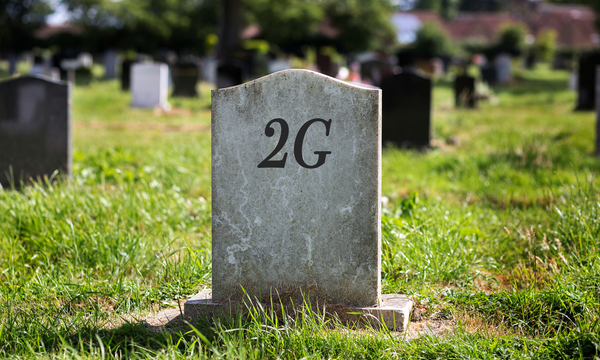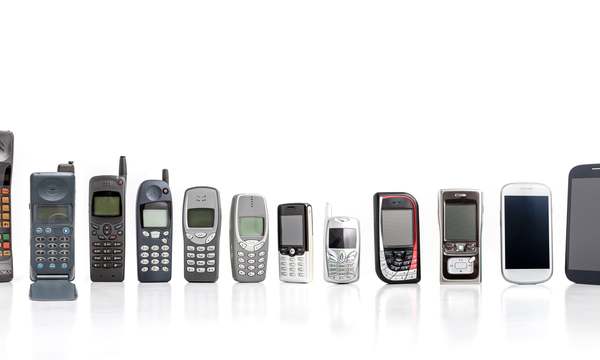
Why 2G wants to live forever
NOKia 1011
Launched in November 1992, the Nokia 1011 was one of the first 2G handsets. Based on the popular 1G Nokia 101 but substantially heavier it was replaced by the 2110 the hit of 2G phones.
There is still a lot to be said for 2G, and many more people use it than you might think. 12 per cent of network connections are made by 2G devices in the UK, according to Real Wireless’ John Okas, lead author of a report for the Spectrum Policy Forum on the impact of switching off 2G in the UK. For all of the 5G hype, that’s means there are more 2G connections today than 5G connections.
Many consumers hang onto their classic Nokia 3310 because it’s easy to use – a modern touch screen is not, and for users who need assistance, a modern interface is cumbersome. Snake remains popular, too. For industrial products, 2G’s components are as cheap as chips, the IP is pretty much freely available, and it’s very well understood.
Replacing the UK’s base of handsets isn’t the biggest problem, however. A phone battery typically has a life of 1000 charges - that’s three or four years between battery replacements. While a smartphone may be handed down to a relative or sold into a second-hand market, the time between new and landfill is about seven years. If you are looking for a phone for your granny, and type “Big Button Mobile” into Amazon, then what you will get is mostly 2G phones, and a smattering of 2G/3G phones. The problem is the legacy industrial applications which use 2G, as these often have a replacement cycle of decades.
GSM is a crucial part of these products and services. It’s in vehicle information systems, or telematics: most BMWs have a 2G system for their connectivity. The network set up for the UK’s smart meters, DCC, uses 2G and 3G but not 4G, and 10 million SMETS2 smart meters support only 2G or 3G. DCC has no plans to upgrade this network.
So 2G is very widely supported. If you take your 4G or 5G phone around the world it will still be able to make calls and send texts, because it supports the 2G network; the complexity of frequencies means that only 2G has the certainty of getting connected. As a result, in many places, we will see 3G phased out while 2G remains. Keeping a bare bones 2G service running would make sense, then. It will ensure that alarm systems, energy meters and your Gran’s phone don’t become museum pieces.
|
GET CW JOURNAL ARTICLES STRAIGHT TO YOUR INBOX Subscribe now |
When I launched What Mobile magazine in 1993, I looked for predictions on mobile phone adoption to assure advertisers and investors. The most bullish figure came from BT Cellnet – which later became O2. Cellnet predicted that in the UK the number of mobile phone users would rise from under a million at the time, to eight million by the year 2000. That seemed rather optimistic: it had taken seven years to sell the first million phones, so an eightfold rise over the next seven years seemed crazy. But I was trying to get WH Smiths to stock my magazine, so that figure went into the PowerPoint.
That year, One 2 One joined the first two operators, Vodafone and Cellnet, and the following year they were joined by Orange, which popularised the mobile phone as a consumer lifestyle. By 2000 the UK had 20 million phones. It was more than anyone had predicted.
There are certainly compelling reasons to turn off 2G and 3G. The radio technology represented the state of the art when it was devised some forty years ago, but has since been superseded. Power amplifiers are better, for example, and modern microprocessors allow much more to be done in software. 2G equipment is very inefficient in terms of power and its use of radio spectrum. This is particularly true of 3G: there is nothing 3G can do, that 4G can’t do better. If we were to switch off 3G today few people would notice. Regulators could then “refarm” the spectrum by reallocating the frequencies used by 3G for use by 4G and 5G.
Orbitel 901
To ensure a supply of 2G phones, Vodafone and Ericsson set up the joint venture Orbitel which made the Orbitel 901, the first appproved 2G phone and the first with text messaging.
But the same is not quite true of 2G. You can keep a skeleton service running with a few hundred kilohertz of spectrum, which is such a small amount, it would not impact 4G or 5G. If a tiny bit of 900 Mhz or 1800 MHz was hived off as a shared 2G band, all the operators could keep that old kit like smart meters running, without sacrificing the better use of frequencies with newer technologies.
There are other reasons for killing off 2G and 3G. One is the continuing use of high risk vendors’ equipment in the mobile networks. Another reason is legacy equipment. The Science and Technology Select Committee reported in January 2021 that there was a need to transition from such legacy installations. The problem is caused by the way 4G and 5G have been deployed. When a site has been upgraded from one technology to its successor, it may have been done by taking away the old equipment and replacing it with new equipment. More often, the upgrade was an addition, so a 2G/3G site which has had 4G added might well have had some extra cells attached to its radio masts. It would be uneconomic to refresh the old equipment, and some of it is now well past the end of its working life. The networks are obliged to have removed all high risk vendor-made equipment by 2027, so taking out 2G and 3G cells to put in Nokia or Ericsson 2G or 3G equipment would be like buying a new black and white television.
The conclusion of the Select Committee seems sound. There is no point in continuing to maintain 3G frequencies, and a real dividend awaits by reusing that spectrum. Keeping 2G running may have some benefits but it would be uneconomic.
GSM once meant Groupe Spécial Mobile, a French acronym, appropriate for a European standard. But as GSM started to become successful outside of Europe some countries were uncomfortable with that. It became the Global System for Mobile (Communications) instead. America took on GSM but at a new frequency of new frequency of 1900 MHz, calling it PCS. However, US carriers had also deployed two rival 2G digital technologies from which the consumer could choose. Qualcomm had developed CDMA, which was the most widely used. And Nextel sold iDEN devices, developed by Motorola, and loved for its push-to-talk walkie talkie feature. All three types of 2G - CDMA, iDEN and the US flavour of GSM - were incompatible. Overall adoption in the early years of the century lagged behind Europe, and as a consequence of this, there was less ‘legacy’ equipment to rip out. Standardisation came with 4G, and every operator had an incentive to remove the old equipment. The last 2G was shut off two years ago, and 3G will be turned off by the end of 2022.
However, it may be possible to keep 2G without incurring some of the disadvantages. To play games written for an old 8-bit computer from the 1980s, such as a Sinclair Spectrum or BBC Micro, you can download an emulator. This is software that allows your modern PC to run the software of that ancient 8-bit computer. The same can be done with mobile technologies - a 4G or 5G radio can be made to emulate a 2G radio - by taking advantage of wireless network simulation, or WNS. Even though 2G and its successors use very different radio techniques, it’s nevertheless possible to emulate 2G inside 4G. Doing so is not trivial, however.
Cambridge seems to be the home of solving this particular radio problem, with both the Mavenir-owned business ip.access and the cell maker cellXica producing equipment that can run 2G and 4G radios at the same time.
Mavenir has developed an enhanced 2G interface radio access technology which is compatible with the Open RAN protocol defined by the O-RAN Alliance. Other manufacturers will be able to use this protocol. Meanwhile, cellXica has developed a technology called GiLTE, pronounced “guilty” it stands for ‘GSM inside LTE’. This transmits a 2G signal alongside a 4G one. It’s a neat solution for not spots, because it can work in the 1800 MHz shared access licence spectrum to provide 4G speeds of up to 10 Mbps. The ubiquity of 2G means that connectivity is guaranteed.
Mavenir has also produced a GSM module which can be run within its 5G system. One of the benefits of 5G is the use of containerisation technologies, and Mavenir has used this to containerise the GSM protocols in the Distributed Unit microservices architecture, the part that connects the cell to the MME. This is very much akin to the PC emulator example.
Both cellXica and Mavenir are relatively small players but they have demonstrated that running 2G in a 4G network is a practical thing to do.
The impact of switching off 2G was examined by consultancy Real Wireless in a government commissioned report published in 2019: www.real-wireless.com/the-potential-impact-of-switching-off-2g-in-the-uk/.
Rather than a ‘big bang’ switch off of 2G and 3G, we may have a better solution: shared spectrum. If the mobile operators make use of these new emulation technologies and kept a little bit of spectrum alive between them we could see 2G live well beyond the 2033 date.
|
DO YOU HAVE A VIEW ON THIS SUBJECT, OR RESPONSE YOU'D LIKE TO SHARE? |
Simon Rockman bridges writing about technology and implementing it. As the editor of UK5G Innovation Briefing he visits many of the 5G applications. As Chief of Staff at Telet Research he works with a team installing 5G networks in not-spots. An experienced technology writer, he was the editor of Personal Computer World in the late 1980s and went on to found What Mobile magazine which he ran for ten years, and has reviewed over 300 handsets. As the mobile correspondent for The Register, he championed CW writing a number of articles supporting the organisation. He has also had senior roles in telecoms having been the Creative Experience Director at Motorola where he looked at new uses for mobile and Head of Requirements at Sony Ericsson where we worked on innovative devices at entry level. He was the Head of the Mobile Money Information Exchange at the GSMA and has launched Fuss Free Phones an MVNO aimed at older users











